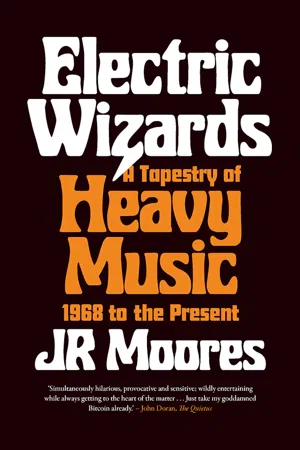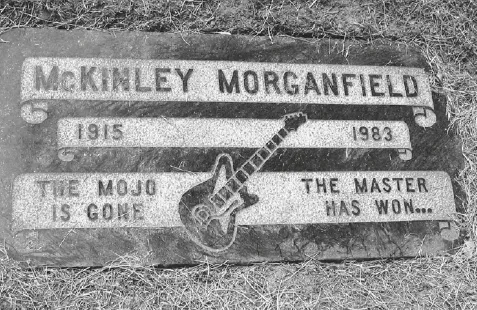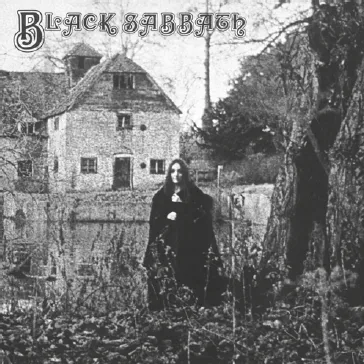![]()
1
THE PREHISTORY
The gravestone of McKinley ‘Muddy Waters’ Morganfield in Restvale Cemetery, Westmont, Illinois.
You get a more pure thing out of an acoustic but you get more noise out of an amplifier.1
MUDDY WATERS
Spoiler alert. There is a brilliant moment that occurs in the very closing moments of 1977’s Interface, the sixth album by the cult Parisian space rock combo Heldon. The album concludes with its title track, one that is so long it fills the whole of the LP’S second side, just as ‘Helter Skelter’ should have been allowed to do. With such room to play with, ‘Interface’ builds up gradually into a roaring tornado of mutating drum patterns, effervescent synthesizer noises and guitar licks that wail into the atmosphere like an abandoned astronaut. Eventually, after around nineteen minutes of futuristic-sounding, avant-garde and alien-like music, this ultramodern cacophony finally fades out and is replaced, to near comic effect, by a final few seconds of traditional blues rock guitar. ‘We were finishing the track, the tape was rolling, and I started to play a normal boogie or whatever,’ recalled Heldon leader Richard Pinhas when interviewed for the album’s 2020 reissue. ‘I think it was a good idea to keep it. It just came naturally, at the end.’2
Sounding incongruous on first listen, the contrast between the track’s main racket and its brief call-back to the blues reminds us just how far rock ’n’ roll had transformed – how the original blueprint had been jolted and nudged down all kinds of unexpected avenues – since its earliest days. By the time Heldon were operating, the genre had branched out into several different mutated forms, and it wasn’t likely to stop there. Rock ’n’ roll had given rise to contorted clones and had shifted into unrecognizable shapes, akin to some extraterrestrial creature from one of the science fiction tales that were so fondly admired by Richard Pinhas himself.
Heldon, as we shall see, represented one of rock ’n’ roll’s most distant relatives thanks to Pinhas’s inventive fusion of abstract rock sounds and weighty Moog pulsations. At the same time, the surprising way in which Pinhas decided to sign off Interface with those trad blues licks reminds us that so many of the records we listen to today, however modern-sounding or fused with electronic elements, all have their roots in earlier genres. This message had already been imparted on Heldon’s earlier third album, a double LP released in 1975. It combined heady synth throbs with expressive blasts of spacey guitar in a decidedly radical fashion, with noticeable similarities to krautrock. Pinhas named the album It’s Always Rock ’n’ Roll.
Waters, Wolf and Tharpe
Paul McCartney may have taken heaviness to a whole new level with ‘Helter Skelter’, but it would be churlish for us to neglect the prehistory. As part of his adventures for compiling the Archive of American Folk Song project for the Library of Congress, Alan Lomax had already recorded the likes of Woody Guthrie and Lead Belly when, in 1941, he arrived in Mississippi, where he hoped to record the legendary blues guitarist Robert Johnson. When Lomax got there, he was informed that Johnson had died two years earlier. Lomax was lucky enough to come across McKinley Morganfield, however, who was otherwise known as Muddy Waters. Then 26 years old and living on the Stovall Plantation near Clarksdale, Morganfield was surprised by how great he sounded when he heard Lomax’s recordings played back to him. His confidence given a vital boost, Morganfield moved to Chicago in 1943 to properly pursue a career in music. With the help of fellow bluesmen including Big Bill Broonzy, Memphis Slim, Sunnyland Slim and Sonny Boy Williamson, Muddy Waters broke into the Chicago scene. The first thing he wanted to do was to get an amplifier. In the crowded, bustling, boozy venues of Chicago where fights and arguments broke out frequently, it was hard for audiences to hear acoustic blues music over the cacophony of their own making. When Waters got hold of that sought-after amplifier, his ensemble would make its name as the first electric blues band. While Muddy Waters may have been the named leader of the group, all members contributed to the overall harsh and energy-emanating sound. This was, in essence, the first rock band, and music would never be the same again.3
Hot on the heels of Muddy Waters, although actually three years his senior, came Chester Arthur Burnett, aka Howlin’ Wolf, who moved to Chicago in 1952. Although Howlin’ Wolf was initially welcomed to town by Waters, the two men become rivals, keeping a close eye on one another’s activities and occasionally luring away each other’s band members. Thanks to a vocal style that managed to out-growl Muddy Waters, and with the assistance of Willie Johnson’s raucous guitar playing and signature distorted guitar sound, Howlin’ Wolf has been cited as the most direct connection between the old blues, hard rock and heavy metal.4
Given his inclination to repeat the tale, Muddy Waters must have been proud of the fact that when he first toured Britain in 1958 the audiences there were apparently unprepared for his electrified take on the blues. According to trad-jazzman Chris Barber, who arranged Waters’ visit and thus played his own crucial part in the history of heaviness, rumours that the music was too shockingly loud for the British crowds were greatly exaggerated, not least by Waters himself. The jazz critic James Asman may have retreated to the back of the audience before fleeing out the door in flamboyant objection to Waters’ racket, but Asman’s complaints were not a reflection of the broader reception. For one thing, the year before Waters’ appearance Barber had booked an artist who had been considerably louder than Muddy Waters. That person was Sister Rosetta Tharpe. ‘She played a very nice Les Paul with a big combi amp and she was louder than my entire band,’ recalled Barber. ‘And nobody complained!’5 Of this godmother of rock, it is said that ‘Nobody – not Chuck Berry, not Scotty Moore, not James Burton, not Keith Richards – played wilder or more primal rock ’n’ roll guitar.’6 The people wanted heavy, even if James Asman didn’t. Soon enough, bands like The Animals, The Rolling Stones, The Yardbirds, Led Zeppelin and Cream were basing their repertoires around these electric blues pioneers.
Surf’s Up
Even those who broke away from the blues in a more inventive fashion had to acknowledge its significance as source material. In 1964 Ringo Starr commented that music by black musicians comprised ‘ninety percent of the music I like’ and described The Beatles’ music as ‘secondhand versions’ of it.7 When they landed in the United States, The Beatles expressed their desire to catch performances of Muddy Waters and another of their rock ’n’ roll heroes, Bo Diddley. ‘Muddy Waters,’ asked one reporter, ‘where’s that?’ The Beatles, laughing, lambasted the Americans for ignorance of their own famous – that is, most important – people.8 It’s an amusing anecdote, albeit one that should be taken with a pinch of salt. Just as James Asman’s dislike of Muddy Waters cannot be said to be representative of other members of the British public, it’s likely that this Beatles anecdote tells us more about one reporter’s obliviousness to Muddy Waters than it does an entire nation’s. Muddy Waters and Bo Diddley did both express gratitude to The Beatles for boosting their popularity with a younger crowd, but they weren’t exactly unheard of.9 For the writer Rob Chapman, ‘the oft-propagated notion that English beat groups reintroduced America to its own black-music heritage is cultural colonialism taken to new delusory heights of condescension.’10 Chapman points to early garage band records and American surf music of the late 1950s and early ’60s as evidence of pre-Beatles American-grown rock music that was full of blues, soul and R&B influences. The garage rock staple ‘Louie Louie’, popularized by The Kingsmen’s ragged and rocked-up version, was originally written in 1955 by the African American musician Richard Berry.
It was later performed by, well, almost everybody. The Kinks. An early incarnation of Pink Floyd. The Troggs (whose ‘Wild Thing’ was also fundamentally a ‘Louie Louie’ rewrite). The Sonics. Led Zeppelin. The Doors. Flamin’ Groovies. MC5. The Stooges (Iggy Pop also recorded it as a solo artist). Lou Reed. Patti Smith. Johnny Thunders. The Clash. Jon the Postman (a cult figure in the Manchester punk scene, who would jump onstage at the end of gigs and perform ‘Louie Louie’ either a cappella or with friendly accompaniment from bands like Buzzcocks and The Fall). Motörhead. Black Flag. The Gun Club. Sisters of Mercy. Smashing Pumpkins. Mudhoney. The list goes on. Name any band and they have almost certainly covered ‘Louie Louie’. And if they haven’t covered it in an official capacity, they’ll at least have jammed around its chords during rehearsals or soundchecks, just as The Beatles did during the Get Back sessions. Although the ever contrary Frank Zappa claimed to consider The Kingsmen’s shambolic version to be a bit of a farce, he still maintained that it was impossible to underestimate the impact of ‘Louie Louie’.11
Alongside garage rock, instrumental surf music also helped to set the scene for future heaviness. While this genre is vast, the music of Link Wray stands out as a particularly crucial prototype. The sound made by this Native American Korean War veteran could get particularly dark and moody, and pre-dates heavy metal in occasionally drawing on scary movies as well as real-life cases of terror. Take the suitably spiky, ominous and unpredictably violent sound of ‘Jack the Ripper’. As schlocky as it is with its bursts of theatrical evil laughter, ‘The Shadow Knows’ anticipates Black Sabbath’s fixation with horror movies and the desire to transfer the atmosphere of what they saw on screen into the grooves of a rock record. Although he was a dexterous enough player, Wray understood the power and capacity of simplicity. Simultaneously astute and innate, Wray’s grasp of elements like tone, distortion, volume and space had a potent effect on the emotions of his listeners. A well-placed chord that rang out for perhaps longer than it should have done, Wray knew, could have a much more intoxicating effect on the heart and mood of a listener than a busy succession of notes that might take up the same space on a track. Neil Young has been called ‘the godfather of grunge’, especially for his output with Crazy Horse. For his own part, Young traces ‘the beginning of grunge’ all the way back – before metal, punk, post-hardcore and noise rock – to the achievements of Link Wray.12
Wray’s 1958 ‘Rumble’ was an especially important track. Helping to popularize the power chord, it would resonate down the ages, providing both direct and filtered-down inspiration to successive generations of riff-centric rock ’n’ rollers, punks, hard rockers and metalheads. When recording ‘Rumble’, Wray dirtied up its sound by physically damaging an amplifier, poking holes in its speaker cone to achieve a fuzzier and more distorted tone, preceding Dave Davies on The Kinks’ ‘You Really Got Me’ by several years. Pete Townshend said that he would never have picked up a guitar in the first place if it wasn’t for Link Wray and that particular seminal track.13 Despite it being solely instrumental, when ‘Rumble’ became popular some U.S. radio stations refused to air it for fear that its violence-alluding title and brooding, malevolent sound would incite juvenile delinquency and gang warfare. They weren’t actually that far off, especially where one notable future delinquent was concerned. When asked about the single most important influence on his own musical career, Iggy Pop pinpointed Link Wray. ‘One day I was in the student union of this major university,’ he remembered, ‘and I heard this music – Duh! Duh! Duuuuh! It was called “Rumble” and it sounded baad. I left school, emotionally, at that moment.’14 Unruly, hedonistic and never knowingly beshirted, the proto-punk trailblazer didn’t look back.
![]()
2
SABBATH PHASE I:
BLACK SABBATH
Only the beginning: Black Sabbath by Black Sabbath.
We’re only here for a short time. We know that. In three years’ time or even next week, they could be saying ‘Who the hell are Black Sabbath?’ We’ll be tomorrow’s Tremeloes. You’ve got to do it while you can.1
OZZY OSBOURNE in 1972
Classical music goes back several hundred years, and electric music only goes back maybe 60 years, so were we able to live long enough, we’d probably see in a few hundred years that those first four Sabbath records are comparable to Beethoven or Mozart.2
AL CISNEROS (SLEEP/OM)
Download Festival, Donington Park, Derby, June 2016. There is torrential rain for much of the weekend. Perhaps thunderclouds are an appropriate accompaniment to Black Sabbath, who are headlining on Saturday night. The main stage has been temporarily renamed The Lemmy Stage, in honour of the recently departed Motörhead leader. Mortality has never been far from the Sabbath mindset, and by this point there is a real sense of an ending. The black-clad original members of the band will soon be septuagenarians. In early 2012 guitarist Tony Iommi was diagnosed with lymphoma, after which the band’s tour dates had to be arranged to fit around his medical treatments. The Download date is part of Sabbath’s final tour, which the band has christened ‘The End’. Singer Ozzy Osbourne has already been diagnosed with Parkin syndrome. In a few years’ time he will discover he has Parkinson’s disease. At the Download performance Osbourne is his usual self: a walking emblem of fragile defiance. Unlike some of the more desperately pumped and overtly macho singers who front other bands on this weekend’s bill, Osbourne resembles a wide-eyed schoolboy who’s found himself trapped inside the body of a slightly feminine old man, as if the plot to the Tom Hanks film ‘Big’ has gone rather awry. Bassist Geezer Butler’s hair is lighter than it was in his youth and, in sharp contrast to his dark outfit, his beard is turning white. It is a shame that his original rhythm section partner is absent from the event. As thrashed out in a number of disgruntled Facebook posts, drummer Bill Ward has failed to see eye to eye with the other members of Sabbath. Ward claims the deal he was offered to tour with them was a joke. Osbourne will later write that Ward’s excuse of being presented with an ‘unsignable contract’ was a smokescreen for the fact that his health was...


